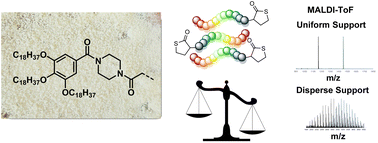Uniform soluble support for the large-scale synthesis of sequence-defined macromolecules†
Abstract
Herein, a monodisperse soluble support is explored and used as an effective tool for the large-scale, liquid-phase synthesis of sequence-defined macromolecules. This support, based on a benzyl derivative with three long hydrophobic alkyl chains, combines the advantages of solid-phase and soluble support- based synthesis by allowing a straightforward workup after each coupling step and a direct characterisation of the intermediates, without prior cleavage from the support. While the soluble support is used for the multi-gram synthesis of thiolactone-based sequence-defined macromolecules, it can be applied for numerous other synthetic strategies too. Additionally, as it is uniform, it leads to a single peak in mass spectrometry and thus not to a molecular weight distribution as typically observed for standard polymeric soluble supports, thus facilitating the characterisation. To demonstrate the potential for the synthesis of sequence-defined macromolecules on a scale that is sufficient for their introduction in bulk material synthesis, a hexamer is prepared on a 14 g scale. Furthermore, two different cleavable linkers have been attached to the uniform soluble support, hence emphasizing the versatility of this strategy.



 Please wait while we load your content...
Please wait while we load your content...